Advertisements
Advertisements
Question
Find the potential difference `V_a - V_b` between the points a and b shown in each part of the figure.
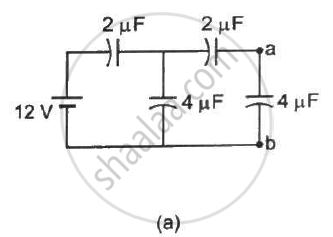
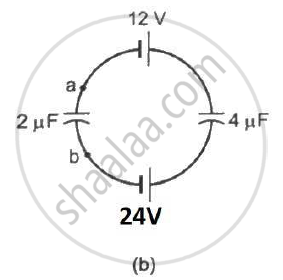
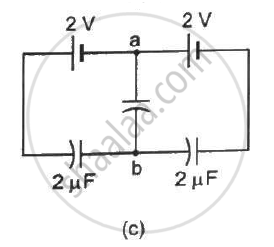
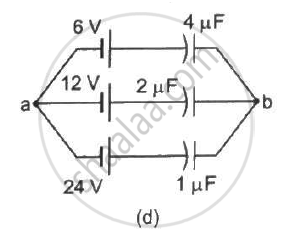
Solution
(a) `q = q_1 + q_2 ..........(1)`
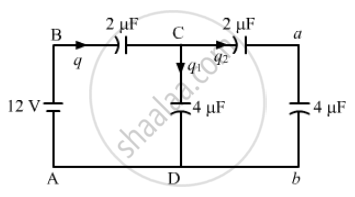
On applying Kirchhoff's voltage law in the loop CabDC, we get
`q_2/2 + q_2/4 - q_1/4 = 0`
`⇒ 2 q_2 + q_2 - q_1 = 0`
`⇒ 3 q_2 = q_1 .............(2)`
On applying Kirchhoff's voltage law in the loop DCBAD, we get
`q/2 + q_1/4 - 12 = 0`
`⇒ (q_1+q_2)/2 + q_1/4 - 12 = 0`
`⇒ 3q_1 + 2q_2 = 48 ............(3)`
From eqs. (2) and (3), we get
`9 q_2 + 2 q_2 = 48`
`⇒ 11q_2 = 48`
`⇒ q_2 = 48/11`
Now,
`V_a - V_b = q_2/(4 "uF") = 48/44 = 12/11 V`
(b) Let the charge in the loop be q.
Now, on applying Kirchhoff's voltage law in the loop, we get
`q/2 + q/4 - 24 +12 = 0`
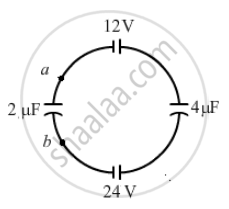
`⇒ (3 q)/4 = 12`
`⇒ q = 16 "uC"`
Now ,
`V_a - V_b = (-q)/(2 "uF")`
`⇒V_a - V_b = (-16 "uC")/(2 "uF") = -8V`
(c) `V_a - V_b = 2-(2-q)/(2 "uF")`

In the loop,
`2+2-q/2-q/2 = 0`
`⇒ q = 4C`
`therefore` `V_a - V_b = 2-4/2 = 2-2 = 0 V`
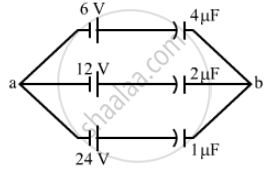
Net Charge flowing through all branches, `q = 24+24+24 = 72 "uC"`
Net capacitance of all branches, C = 4 + 2 + 1 = 7 μF
The Total potential difference (V) between points a and b is given by
`V= q/c`
`⇒ V = 72/7 = 10.3 "V"`
As the negative terminals of the batteries are connected to a, the net potential between points a and b is -10.3 V .
APPEARS IN
RELATED QUESTIONS
Draw a labelled diagram of Van de Graaff generator. State its working principle to show how by introducing a small charged sphere into a larger sphere, a large amount of charge can be transferred to the outer sphere. State the use of this machine and also point out its limitations.
In the figure shown, an ammeter A and a resistor of 4 Ω are connected to the terminals of the source. The emf of the source is 12 V having an internal resistance of 2 Ω. Calculate the voltmeter and ammeter readings.
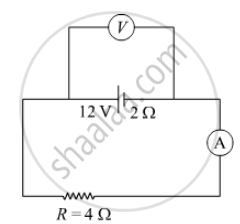
Is there any restriction on the upper limit of the high voltage set up in Van de Graff generator machine? Explain.
The figure shows a plot of three curves a, b, c, showing the variation of photocurrent vs collector plate potential for three different intensities I1, I2and I3 having frequencies v1, v2 and v3 respectively incident of a photosensitive surface.
Point out the two curves for which the incident radiations have same frequency but different intensities.
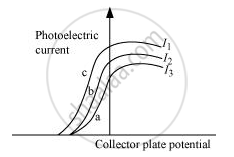
A 100 pF capacitor is charged to a potential difference of 24 V. It is connected to an uncharged capacitor of capacitance 20 pF. What will be the new potential difference across the 100 pF capacitor?
Find the potential difference between the points A and B and between the points B and C of the figure in steady state.

A charge of `+2.0 xx 10^-8 C` is placed on the positive plate and a charge of `-1.0 xx 10^-8 C` on the negative plate of a parallel-plate capacitor of capacitance `1.2 xx 10^-3 "uF"` . Calculate the potential difference developed between the plates.
A charge of 1 µC is given to one plate of a parallel-plate capacitor of capacitance 0⋅1 µF and a charge of 2 µC is given to the other plate. Find the potential difference developed between the plates.
The capacitance between the adjacent plates shown in the figure is 50 nF. A charge of 1.0µC is placed on the middle plate. If 1.0 µC is placed on the upper plate instead of the middle, what will be the potential difference between (a) the upper and the middle plates and (b) the middle and the lower plates?
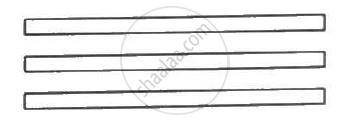
A capacitor having a capacitance of 100 µF is charged to a potential difference of 50 V. (a) What is the magnitude of the charge on each plate? (b) The charging battery is disconnected and a dielectric of dielectric constant 2⋅5 is inserted. Calculate the new potential difference between the plates. (c) What charge would have produced this potential difference in absence of the dielectric slab. (d) Find the charge induced at a surface of the dielectric slab.
What will be the potential difference in the circuit when direct current is passed through the circuit?
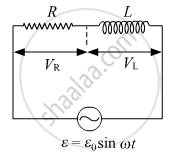
If a positive charge moves in the direction of the electric field ______.
The unit of potential difference as used in electrical circuits is ________.
Assertion: Electric potential and electric potential energy are different quantities.
Reason: For a system of positive test charge and point charge electric potential energy = electric potential.
- It depends only on the initial and final position.
- It is the work done per unit positive charge in moving from one point to other.
- It is more for a positive charge of two units as compared to a positive charge of one unit.
A and B are two points in an electric field. If the work done in carrying 4.0C of electric charge from A to B is 16.0 J, the potential difference between A and B is:
A bullet of mass of 2 g is having a charge of 2 µc. Through what potential difference must it be accelerated, starting from rest, to acquire a speed of 10 m/s.
Work done in moving a unit positive charge through a distance of x meter on an equipotential surface is:-
Can there be a potential difference between two adjacent conductors carrying the same charge?
